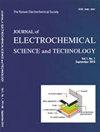两种烯酮二硫缩醛衍生物对不锈钢在盐酸溶液中的缓蚀性能
IF 3
4区 工程技术
Q3 ELECTROCHEMISTRY
Journal of electrochemical science and technology
Pub Date : 2021-12-17
DOI:10.33961/jecst.2021.00822
引用次数: 1
摘要
合成了2-(1,3-二硫杂环丁烷-2-亚基)-3-氧代丁酸甲酯(MDYO)和2-(1,3二硫杂环戊烷-2-亚基,表面分析技术(SEM/EDX和拉曼光谱)和功能密度理论(DFT)也被用于计算量子参数。结果表明,MDYO和DYCD的缓蚀效率随浓度的增加而增加,在所研究的浓度范围(0.01×10-3-10-3M)内缓蚀效率最高。极化曲线(Tafel外推)表明,这两种化合物在1M HCl溶液中都是混合型抑制剂。电化学阻抗谱(奈奎斯特图)的特征是在高频下观察到的电容回路和在低频附近观察到的另一个小电感回路。测定了两种化合物在不锈钢表面吸附的热力学数据和活化能,并对其进行了讨论。实验结果分析表明,根据Langmuir模型,MDYO和DYCD抑制剂吸附在金属表面,两种抑制剂的吸附机理都涉及物理吸附。SEM-EDX结果证实了在不锈钢表面上存在抑制剂保护膜。理论计算的结果支持了实验观察。本文章由计算机程序翻译,如有差异,请以英文原文为准。
Corrosion Inhibition Performance of Two Ketene Dithioacetal Derivatives for Stainless Steel in Hydrochloric Acid Solution
The methyl 2-(1,3-dithietan -2- ylidene)-3-oxobutanoate (MDYO) and 2-(1,3-dithietan-2-ylidene) cyclohexane -1,3-dione (DYCD) were synthesized and tested at various concentrations as corrosion inhibitors for 316L stainless steel in 1 M HCl using weight loss, electrochemical impedance spectroscopy (EIS), potentiodynamic polarization (PDP), surface analysis techniques (SEM / EDX and Raman spectroscopy) and Functional Density Theory (DFT) was also used to calculate quantum parameters. The obtained results indicated that the inhibition efficiency of MDYO and DYCD increases with their concentration, and the highest value of corrosion inhibition efficiency was determined in the range of concentrations investigated (0.01 × 10 -3 - 10 -3 M). Polarization curves (Tafel extrapolation) showed that both compounds act as mixed-type inhibitors in 1M HCl solutions. Electrochemical impedance spectra (Nyquist plots) are characterized by a capacitive loop observed at high frequencies, and another small inductive loop near low frequencies. The thermodynamic data of adsorption of the two compounds on the stainless steel surface and the activation energies were determined and then discussed. Analysis of experimental results shows that MDYO and DYCD inhibitors adsorb to the metal surface according to the Langmuir model and the mechanism of adsorption of both inhibitors involves physisorption. SEM-EDX results confirm the existence of an inhibitor protective film on the stainless steel surface. The results derived from theoretical calculations supported the experimental observation.
求助全文
通过发布文献求助,成功后即可免费获取论文全文。
去求助
来源期刊

Journal of electrochemical science and technology
ELECTROCHEMISTRY-
CiteScore
6.30
自引率
8.10%
发文量
44
期刊介绍:
Covering fields:
- Batteries and Energy Storage
- Biological Electrochemistry
- Corrosion Science and Technology
- Electroanalytical Chemistry and Sensor Technology
- Electrocatalysis
- Electrochemical Capacitors & Supercapcitors
- Electrochemical Engineering
- Electrodeposition and Surface Treatment
- Environmental Science and Technology
- Fuel Cells
- Material Electrochemistry
- Molecular Electrochemistry and Organic Electrochemistry
- Physical Electrochemistry
- Solar Energy Conversion and Photoelectrochemistry
 求助内容:
求助内容: 应助结果提醒方式:
应助结果提醒方式:


